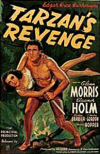|
 Sensing a weakness in the MGM series, Sol Lesser decided to
exercise his remaining Tarzan film right. He assigned screenwriters Robert Lee
Johnson and Jay Vann to work up a story and set about casting. Since the last three screen Tarzans had been Olympic athletes, he
began following sports closely. The 1936 Olympic decathlon champion,
Glenn
Morris, came to his attention in January, 1937, when Morris was awarded the
Sullivan Award, which is given to the outstanding amateur athlete of the year. Morris, who had been a famed footballer at Colorado State College of
Agriculture, won the Award over Jesse Owens, the triple Olympic champion Negro
sprinter. Sensing a weakness in the MGM series, Sol Lesser decided to
exercise his remaining Tarzan film right. He assigned screenwriters Robert Lee
Johnson and Jay Vann to work up a story and set about casting. Since the last three screen Tarzans had been Olympic athletes, he
began following sports closely. The 1936 Olympic decathlon champion,
Glenn
Morris, came to his attention in January, 1937, when Morris was awarded the
Sullivan Award, which is given to the outstanding amateur athlete of the year. Morris, who had been a famed footballer at Colorado State College of
Agriculture, won the Award over Jesse Owens, the triple Olympic champion Negro
sprinter.
After casting the elated Morris as Tarzan, Lesser than contracted
for Eleanor Holm Jarrett, champion backstroke swimmer, who had been dropped from
the U.S. Olympic team for breaking training rules on the way to the 1936 Olympic
games, to play the romantic lead. Johnson and Vann rewrote their script of
Tarzan's Revenge to employ Miss Holm's swimming ability. She more
or less played herself in the film and was called Eleanor, even though she
became the ape man's mate at the conclusion. Lesser's explanation of this
scripting was that, "being so well-known, Eleanor would not have been as
acceptable to the general public as Jane."
Tarzan's Revenge was filmed by Lesser's Principal
Productions on the back lots of Twentieth Century-Fox, and it was distributed by
that company. D. Ross Lederman was director of this low-budget project.
Its rather unconvincing plot had Eleanor and her millionaire parents (George
Barbier and Hedda Hopper) hunting big game in the jungle, accompanied by her
sniveling fiancée (George Meeker). A swarthy,
turbaned nabob called Ben Alleu Bey (C. Henry Gordon) marked Eleanor as an
addition to his 100-wife harem. But Tarzan, who also took a fancy to her,
stole her away for himself.
Tarzan's Revenge was Lesser's worst failure of the sixteen Tarzan films
he eventually produced. He himself called it a "cheap quickie."
"Morris was no actor," he said. Time didn't think so either: "This new
Tarzan is lean, 6 ft. 2 in.
Glenn Morris, summoned to replace
Johnny
Weissmuller... {He} heroically combines the facial qualities of Broadway's
Burgess Meredith and Hollywood's Harpo Marx, but has the acting ability of
neither."
Released on January 7, 1938, Tarzan's Revenge lacked the
gloss and spectacular of the MGM films. The reviews reflected its
dullness. Film Daily said "it suffers from repetition and a slow pace."
Variety: "Even the youngsters, at which this type of production is aimed, will
not be much impressed." "It's greatest lack," wrote John Mosher in the New
York, "is in the two leads. {Both} have many rows to hoe before they can
be called actors...either good or bad." Liberty magazine went so far as to
call Miss Holm "one of the year's worst actresses."
In addition to lowering the Tarzan films another notch,
Revenge also caused considerable confusion as to who was really Tarzan.
There was Weissmuller; but here were other pretenders to the loincloth—Morris
and Herman Brix, who was making the rounds in the re-hash, Tarzan and the
Green Goddess. Fortunately,
Buster Crabbe, who was still remembered
from his 1933 appearance, was really
Flash Gordon and couldn't be Tarzan, but
that still left two Tarzans too many.
At a Hollywood party, while Tarzan's Revenge was still in
production, Morris was introduced as the new Tarzan.
Lupe Velez, who was
present without Weissmuller, ran up to Morris and kicked him in the shins.
"You are not heem! There is onlee one Tarzan. And that's my Johnnee!"
she cried.
The confusion arising from three Tarzans was dispelled when
Tarzan Finds a Son was released the following year. This picture
affirmed Weissmuller's position as king of the cinema jungle until he chose to
turn in his loincloth in 1948. With Lesser having produced his last film
right, exclusive rights to the Tarzan character reverted to MGM as had been
promised by their 1931 contract. Metro and Weissmuller had out-Tarzaned
all the others.
Shortly after Tarzan's Revenge opened, Tarzan Morris sped
back to his home town, Denver, Colorado, to escape the reviews. He then
reappeared in Los Angeles and became a successful insurance agent. When
Pearl Harbor was attacked, he enlisted in the Navy, earned the rank of an
officer, was wounded in combat, and spent a great deal of time recovering in the
Navy Hospital in San Francisco. He never made another film. [Not true;
he was in Hold That Coed later in 1938 ― Doctor Macro].
Neither did Eleanor Holm, who resumed her swimming career in Billy Rose's
"Aquacade." |
